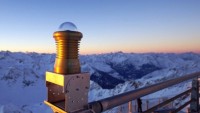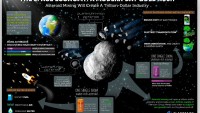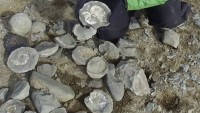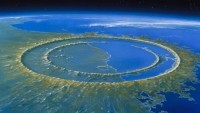Today’s Asteroid Day; Should we all be Scared?
| Arthur Dominic Villasanta | | Jun 29, 2016 11:28 PM EDT |
(Photo : NASA/JPL/Caltech) This NASA graphic shows the orbits of all the 1,400 known Potentially Hazardous Asteroids as of early 2013 overlaid on the orbits of Earth and other inner planets.
June 30 is "Asteroid Day," which is here to remind us that what happened to the dinosaurs 66 million years ago when a 9 kilometer-wide asteroid struck the sea off Mexico will definitely occur again sometime in the future.
This, the K-Pg Extinction Event, wiped-out the dinosaurs and over 90 percent of life on Earth.
Like Us on Facebook
Asteroid Day, however, marks the 108th anniversary of the "Tunguska Event" in Siberia when the largest asteroid ever seen exploded in mid-air above a forest close to the Stony Tunguska River. This incredibly powerful explosion estimated at 15 million tons of TNT laid waste to 2,000 square kilometers of forest but caused no human casualties in this desolate and sparsely populated wilderness.
The 1908 Tunguska asteroid was estimated at only 190 meters wide. It's the largest known impact event on Earth in recorded history.
The threat of deadly asteroids hitting the Earth and causing horrific loss of life is real since over a million asteroids have the potential to hit the Earth. Despite their best efforts, scientists worldwide have only discovered one percent of these asteroids, according to Asteroid Day, an organization hoping to prevent an asteroid from again practically wiping out life on Earth.
The goal of the talks, seminars and movies about asteroids to be held around the world today is to increase awareness about these deadly hunks of space rock, said Grigorij Richters, who founded the organization along with astrophysicist Brian May and three others.
"This year we really got some solid support from the space agencies. NASA and everyone is on board. We're doing more than ever before," said Richters.
Asteroid Day has launched the "100X Declaration" that calls on governments to increase their asteroid discovery rate 100 times -- to 100,000 -- within the next decade. Some 17,000 individuals have signed the online declaration.
"The more we learn about asteroid impacts, the clearer it became that the human race has been living on borrowed time," said May.
In August 2013, NASA released a new map of "potentially hazardous asteroids" (PHAs) showing the orbital paths of more than 1,400 asteroids known approach too dangerously close to the Earth. None of the asteroids mapped pose an impact threat to Earth within the next 100 years, however, said NASA.
"These are the asteroids considered hazardous because they are fairly large (at least 460 feet or 140 meters in size), and because they follow orbits that pass close to the Earth's orbit (within 4.7 million miles or 7.5 million kilometers)," according to NASA.
TagsAsteroid Day, June 30, K-Pg Extinction Event, Tunguska Event
©2015 Chinatopix All rights reserved. Do not reproduce without permission
 France Sets-up one of the World’s Largest Meteorite Detection Networks
France Sets-up one of the World’s Largest Meteorite Detection Networks Luxembourg Invests $225 million to Dominate Trillion Dollar Asteroid Mining Industry
Luxembourg Invests $225 million to Dominate Trillion Dollar Asteroid Mining Industry Asteroid that Exterminated the Dinosaurs also Wiped-out Life in Antarctica and the Arctic
Asteroid that Exterminated the Dinosaurs also Wiped-out Life in Antarctica and the Arctic Killer Asteroid that Destroyed the Dinosaurs Led to the Rise of the Human Race
Killer Asteroid that Destroyed the Dinosaurs Led to the Rise of the Human Race
EDITOR'S PICKS
-

Did the Trump administration just announce plans for a trade war with ‘hostile’ China and Russia?
-

US Senate passes Taiwan travel bill slammed by China
-

As Yan Sihong’s family grieves, here are other Chinese students who went missing abroad. Some have never been found
-

Beijing blasts Western critics who ‘smear China’ with the term sharp power
-

China Envoy Seeks to Defuse Tensions With U.S. as a Trade War Brews
-

Singapore's Deputy PM Provides Bitcoin Vote of Confidence Amid China's Blanket Bans
-

China warns investors over risks in overseas virtual currency trading
-

Chinese government most trustworthy: survey
-

Kashima Antlers On Course For Back-To-Back Titles
MOST POPULAR
LATEST NEWS
Zhou Yongkang: China's Former Security Chief Sentenced to Life in Prison

China's former Chief of the Ministry of Public Security, Zhou Yongkang, has been given a life sentence after he was found guilty of abusing his office, bribery and deliberately ... Full Article
TRENDING STORY

China Pork Prices Expected to Stabilize As The Supplies Recover

Elephone P9000 Smartphone is now on Sale on Amazon India

There's a Big Chance Cliffhangers Won't Still Be Resolved When Grey's Anatomy Season 13 Returns

Supreme Court Ruled on Samsung vs Apple Dispute for Patent Infringement

Microsoft Surface Pro 5 Rumors and Release Date: What is the Latest?










